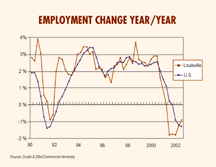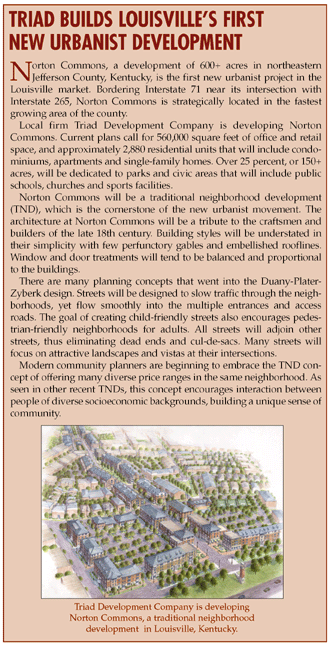LOCATION, LOCAL BUSINESSES PAY OFF FOR LOUISVILLE
Robert B. Walker
 Louisville,
Kentucky, has consistently been recognized as one of the best places to
live in the United States. The cost of living in Louisville is approximately
6 percent below the national average. While maintaining a low cost of
living, Louisville's economy has outperformed the U.S. economy in many
areas, including job growth of 16.9 percent and income growth of 45.6
percent. In addition to a strong economy and low cost of living, Louisville
has many other competitive advantages, such as logistics/distribution,
healthcare/biomedicine, information technology and financial services,
as well as traditional manufacturing. Louisville,
Kentucky, has consistently been recognized as one of the best places to
live in the United States. The cost of living in Louisville is approximately
6 percent below the national average. While maintaining a low cost of
living, Louisville's economy has outperformed the U.S. economy in many
areas, including job growth of 16.9 percent and income growth of 45.6
percent. In addition to a strong economy and low cost of living, Louisville
has many other competitive advantages, such as logistics/distribution,
healthcare/biomedicine, information technology and financial services,
as well as traditional manufacturing.
The Greater Louisville region has added more than 50,000 net jobs, $3
billion in payroll growth and well over $1.5 billion in business investment
over the last 5 years. MSA population recently exceeded 1 million, and
with city and county governments merging in 2003, Louisville expects this
growth to continue.
Office
The Louisville office market consists of more than 17.5 million square
feet in nearly 300 buildings measuring 5,000 square feet or larger. Louisville's
office market slipped quietly into a mini-recession mid-year 2000 as evidenced
by a significant decline in leasing activity and net absorption during
the third and fourth quarters. The sluggishness continued into the first
quarter of 2001, but the market began to show some signs of recovery during
the second and third quarters. Unfortunately the recovery was not sustainable
as leasing activity and net absorption declined in the fourth quarter.
With positive net absorption in the first half of 2002 as larger tenants
took advantage of favorable market conditions, vacancy rates are expected
to decline somewhat throughout the balance of the year.
The central business district (CBD) represents 51 percent of the entire
market with 8.9 million square feet in more than 90 buildings. The overall
CBD has been stagnant in recent years with slowed leasing activity and
four consecutive quarters of negative net absorption in 2001. Despite
disappointing performance in the overall CBD, the Class A market has performed
well throughout this recession with the Class A vacancy rate never exceeding
7 percent and falling to 6.4 percent in the first quarter of 2002. This
compares to the overall CBD vacancy rate of 15.9 percent in the first
quarter of 2002. With excitement building in the CBD over a retail project
called 4th Street Live planned by The Cordish Company of Baltimore, expect
vacancy rates to decrease as leasing activity increases.
The Louisville CBD experienced its first significant new construction
in more than a decade during the second quarter of 2002, and more projects
are under construction. With 61,562 square feet of leasing activity and
net absorption of 52,227 square feet, the Louisville CBD is showing signs
that it may be recovering.
The suburban office market in Louisville has experienced a plethora of
new construction completions in recent years averaging approximately 570,000
square feet of construction completions per year over the last 3 years.
With more than 800,000 square feet coming on line in 2001, new construction
caused an increase in suburban Class A vacancy rates from 9.8 percent
in the first quarter of 1999 to 26 percent in the first quarter of 2002.
New construction increased the Class A inventory from 2.5 million in the
first quarter of 1999 to 4.25 million in the first quarter of 2002, increasing
the overall suburban vacancy rate to 19.3 percent and the suburban inventory
to 8.69 million square feet, nearly surpassing the inventory of the CBD.
Although the suburban market vacancy rate has increased, suburban leasing
activity has been very strong considering the Louisville market has been
in a real estate recession since the third quarter of 2000. The suburban
market has also shown signs of a recovery during the first half of 2002.
As the construction pipeline continues to empty, increased leasing activity
and positive net absorption should begin to reduce the unusually high
Class A vacancy rate as well as the overall suburban vacancy rate.
Industrial
The Louisville industrial market consists of nearly 1,500 buildings,
10,000 square feet or larger, and totals more than 94.5 million square
feet. After a record-setting year in 1999 and a very strong first half
of 2000, the industrial market activity has been anemic at best.
In comparison to the office market, the industrial market has been affected
more negatively by the current real estate recession. Sales and leasing
declined significantly from 5.9 million square feet in 1999 to 4.5 million
in 2000, 3.2 million of which came in the first 6 months of the year.
Sales and leasing activity declined even further to 4.1 million in 2001.
Net absorption also decreased from nearly 2.8 million square feet absorbed
in 1999 to 1.5 million in 2000 after absorbing more than 1.6 million square
feet in the first two quarters of 2000. Net absorption decreased dramatically
in 2001 to 246,452 square feet, less than 9 percent of the 1999 level.
Despite the decline in activity and net absorption, the Louisville industrial
market has experienced a plethora of new construction completions totaling
more than 7.2 million square feet from 1999 through 2001. This new construction
has left the Louisville industrial market poised with over 5 million square
feet of high-quality distribution facilities waiting for the economy to
recover. Fortunately, both leasing activity and net absorption are expected
to improve throughout the calendar year; consequently, vacancy rates are
expected to decline as construction activity subsides.
The explosive growth of the distribution market in Louisville, fueled
in large part by the growing presence of United Parcel Service, has forced
industrial development beyond the confines of Jefferson County. The shortage
of available land for new industrial developments in Jefferson County
has sparked the development of two new industrial parks outside the county
at Cedar Grove in Bullitt County and Kingbrook in Shelby County. These
two industrial parks have been successful due to convenient access to
the interstate highway system and the UPS hub at Louisville International
Airport. Industrial parks outside Jefferson County will continue to develop
throughout 2002 and beyond because of Louisville's central location, interstate
highway access, UPS and the fact that 50 percent of the nation's population
is within a day's drive of Louisville.
Retail
The Louisville retail area encompasses a metropolitan statistical area
of just over 1 million people. Recent retail activity has paralleled that
of most cities throughout the region, with its share of big-box vacancy
as well as absorption of the well-located spaces by retailers wanting
to expand in the Louisville marketplace.
 "Preston
Highway/Outer Loop-CBL owns the 1.1 million-square-foot Jefferson Mall,
which has been the benchmark retail piece of this area," says Doug Butcher
of CB Richard Ellis/Nicklies in Louisville. Adjacent to the Jefferson
Mall, Jacobs is developing a Target-anchored power center. Wal-Mart, which
is across the street from Jefferson Mall, is in the planning and rezoning
stage to develop a Wal-Mart Supercenter. "Preston
Highway/Outer Loop-CBL owns the 1.1 million-square-foot Jefferson Mall,
which has been the benchmark retail piece of this area," says Doug Butcher
of CB Richard Ellis/Nicklies in Louisville. Adjacent to the Jefferson
Mall, Jacobs is developing a Target-anchored power center. Wal-Mart, which
is across the street from Jefferson Mall, is in the planning and rezoning
stage to develop a Wal-Mart Supercenter.
Further south on Preston Highway in the I-265 area are new Kohl's, Wal-Mart
Supercenter, Lowe's Home Improvement Warehouse and Home Depot locations,
Butcher continues. "Preston Highway runs into Bullitt County, which is
considered part of metro Louisville. There have been numerous residential
developments in this area. The town of Shepherdsville has plans for a
new Kroger center development. Currently a Winn-Dixie-anchored center
dominates the market."
The overall retail market in 2002 is softer than the previous 2 years
because of national retail tenants closing Louisville locations and lackluster
retail activity in the metropolitan area. Recently, positive job growth
has been encouraging and retailers that are surviving in Louisville are
also looking to expand in Louisville.
There are very distinct retail locations that provide regional, community
and neighborhood draws that will continue to be successful for the long
term. Many national, regional and local tenants recognize these distinct
retail locations and continue to expand into these locations when availability
comes up. Currently, the best large neighborhood locations available are
from the closure of a several Winn-Dixie stores throughout the marketplace.
Although Winn-Dixie continues to operate successfully in Louisville, the
retailer has closed a number of stores above 30,000 square feet that provide
opportunity for retailers to market to the neighborhoods. Additional community
locations have been created by the closure of Service Merchandise, Franks
Nursery, Drug Emporium, Furrow's and Kmart. This list is parallel to other
cities that are comparable to Louisville's size and allows expanding tenants
to backfill these locations in other cities as well as look at Louisville
for expansion opportunities.
Fortunately for Louisville, there is a long list of retailers wanting
to backfill the coming vacancies, as well as expand their presence in
Louisville. These retailers include Barnes & Noble, Borders Books & Music,
PetsMart, Staples, Marshalls, Dick's Clothing and Sporting Goods, Kohl's,
Lowe's Home Improvement Warehouse and Target. These tenants are either
looking in Louisville or have expanded their presence in the Louisville
marketplace into better locations or locations they were not serving in
the past.
Louisville and Jefferson County governments will merge into one metro
government beginning in 2003. The new government, touting the CBD as a
destination location, has entered into an agreement with The Cordish Company
to redevelop the Galleria downtown. The Cordish Company plans to develop
a themed retail center, which will have a high-energy entertainment base
of retailers, creating greater activity in downtown Louisville. The Cordish
Company plans to begin construction in late 2002 and finish construction
sometime in late 2003, with an entertainment-style retail center known
as 4th Street Live in the heart of downtown Louisville.
Louisville has recently attracted retail developers interested in redeveloping
in-fill sites by bringing national tenants to these sites and doing cosmetic
overhaul to create a more exiting shopping environment for the neighborhood
and community shopping areas. BC Wood Companies recently acquired approximately
500,000 square feet in Louisville. The company plans to reposition the
Dixie Manor and Iroquois Manor shopping centers by bringing Marshalls
and Staples to these centers as new tenants.
Robert Walker is director of research services with Grubb & Ellis|
Commercial Kentucky, Inc.
©2002 France Publications, Inc. Duplication
or reproduction of this article not permitted without authorization
from France Publications, Inc. For information on reprints of
this article contact Barbara
Sherer at (630) 554-6054.
|
